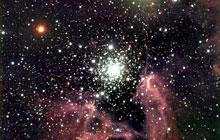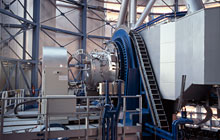ISAAC
Infrared Spectrometer And Array Camera
 ISAAC was the first Very Large Telescope (VLT) multimode instrument developed by ESO. Together with its “son”, SOFI, it was part of a new generation of machines working at infrared wavelengths, an underexploited field at that time, due to slower progress in the development of the astronomical detectors.
ISAAC was the first Very Large Telescope (VLT) multimode instrument developed by ESO. Together with its “son”, SOFI, it was part of a new generation of machines working at infrared wavelengths, an underexploited field at that time, due to slower progress in the development of the astronomical detectors.
Installed in November 1998 on VLT Unit Telescope 1 (Antu), ISAAC could look into the dusty Universe — a previously hidden realm. Visible light cannot penetrate the huge clouds of dust found throughout the Universe, and before ISAAC and others of its kind were invented, astronomers had no way of knowing what lies behind or within these clouds. ISAAC quickly got to work on a variety of objects in the infrared Universe, from star-forming regions in the Milky Way to distant galaxies.
 ISAAC was unique. In 1998 infrared studies were considered a dark art, because of the very limited field of view of infrared instruments, and because of the complexity of the observation procedures. ISAAC and SOFI were the first multimode instruments with two-dimensional detectors in the near infrared , “making it essentially a near-infrared EMMI,” says Claus Madsen in his book The Jewel on the Mountaintop. In a few seconds, ISAAC could be converted from an imaging camera into a spectrograph, and it could also measure the polarisation of the light; furthermore, the complexity of the infrared observations was hidden in pre-defined sequences, allowing even non-expert astronomers to perform them.
ISAAC was unique. In 1998 infrared studies were considered a dark art, because of the very limited field of view of infrared instruments, and because of the complexity of the observation procedures. ISAAC and SOFI were the first multimode instruments with two-dimensional detectors in the near infrared , “making it essentially a near-infrared EMMI,” says Claus Madsen in his book The Jewel on the Mountaintop. In a few seconds, ISAAC could be converted from an imaging camera into a spectrograph, and it could also measure the polarisation of the light; furthermore, the complexity of the infrared observations was hidden in pre-defined sequences, allowing even non-expert astronomers to perform them.
During its time of service ISAAC was used to make infrared images and spectra at wavelengths from 0.9–5 micrometres (up to seven times longer than can be seen by the human eye) achieving science highlights such as the most distant object discovered in the Universe in 2009 (eso0917) and observations of quasars that reconciled observations with astronomical models (eso0821).
To achieve maximum sensitivity, the complete optical system of ISAAC was housed in a large vacuum vessel with a diameter of 1.7 metres and cooled to a temperature of -200º C. It had two independent arms, each possessing a detector of 1024 x 1024 pixels that covered a wide range of infrared wavelengths. While 1 megapixel sounds modest by today's standards for digital cameras, these were then state-of-the-art detectors.
Now, ISAAC is resting. It was removed from its final home on Unit Telescope 3 to allow SPHERE to be installed. The last data taken with ISAAC were obtained on a bright star in the Orion Nebula on 12 December 2013, but its legacy at the VLT remains.
Science highlights with ISAAC
- Accretion discs show their true colours (eso0821)
- The most distant object discovered in the Universe (eso0917)
- ISAAC observes Jupiter occultation (eso9860)
- Discovery of most massive stars to date (eso1030)
- Dwarf planet Makemake lacks atmosphere (eso1246)
Additional Images
A raw image from ISAAC
This raw ISAAC image was used, combined with many others, to generate the photo at the top of this page. All the images taken with astronomical instruments are monochromatic: the information on the colour is obtained by taking exposures through different filters. In infrared light, the sky is so bright that individual exposures must be kept very short. To reach the long total exposure time needed, hundred of exposures are combined. The dark spots are defects of the detector, and the bright line in the centre marks the separation between the areas of the detector processed by different electronics.
A raw spectrum from ISAAC
A long, narrow slit isolates a small strip of sky. On this image, the slit is vertical, and slightly curved by the optics in ISAAC. The spectrograph then splits the light from the slit into its individual infrared colours, each point of the slit forming a horizontal rainbow. In the lower part, the horizontal fuzzy line is the spectrum of a faint galaxy. The glowing areas on the edge mark the position of the four amplifiers dealing each with a quarter of the detector. These electronic devices are slightly warmer than the rest, causing a minute amount of infrared light registered by the detector.
ISAACThe authoritative technical specifications as offered for astronomical observations are available from the Science Operation page.
|


